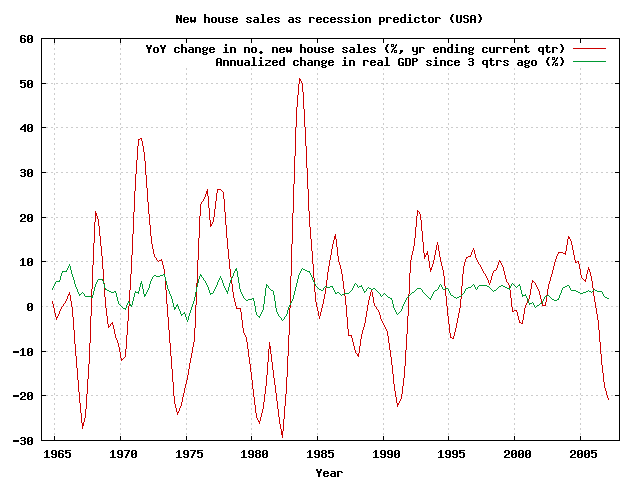LVRG Scrapbook — Wednesday, May 30, 2007:
New home sales as a predictor of U.S. recessions
By Gavin R. Putland
I assembled the monthly figures on new house sales (which are obviously related to construction) into quarterly figures...

The green curve shows the change in real quarterly GDP since 3 quarters earlier (converted to an annual rate of change); the GDP figures are from www.bea.gov/national, under ‘Current-dollar and “real” GDP’. This curve goes negative three to six months after the onsets of recognized recessions. It correctly shows the double dip in the early '80s, and barely recognizes the non-technical “recession” of 2000–2001 (which involved three alternate quarters of negative growth).
The red curve shows the year-on-year change in new (single-family) house sales, where the “years” are consecutive and the second “year” ends in the current quarter.
The combined graph gives one clear conclusion: To the extent that new home sales are an indicator of recessions, they are a leading indicator. Notice that the red curve always goes negative before the green curve does, with a margin of one to two years. This is in spite of the fact that the red curve lags further behind the data on which it is based; the red curve is based on the last eight quarters, while the green curve is based on two of the last four quarters.
But to what extent are new home sales an indicator? The 2000–1 “recession” followed a very mild sales downturn (with a bit of help from the dotcom crash and 9/11), whereas deeper sales downturns in 1994–5 and 1966 gave no recessions. The chance of recession seems to increase when the dip in sales follows a high peak; see the peaks of 1968, 1971, 1976–7. But there is no “bubble line”, and it strains credulity to suggest that the peak of 1983 had anything to do with the recession of the early 90s; indeed, it can be seen at a glance that the sales peaks are associated with recoveries from recessions or slowdowns in growth.
In short, new home sales are a definitely a leading indicator of recession, but not a strikingly reliable indicator...
[From an email to the Prosper Australia executive, May 30, 2007. Reposted Feb.18, 2009.]



